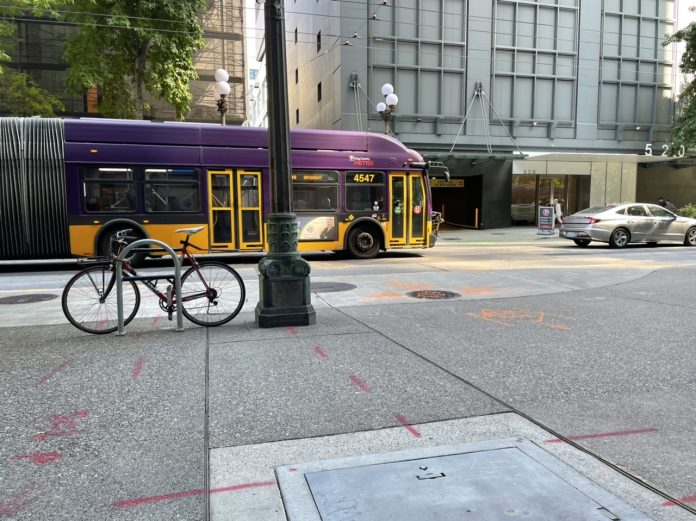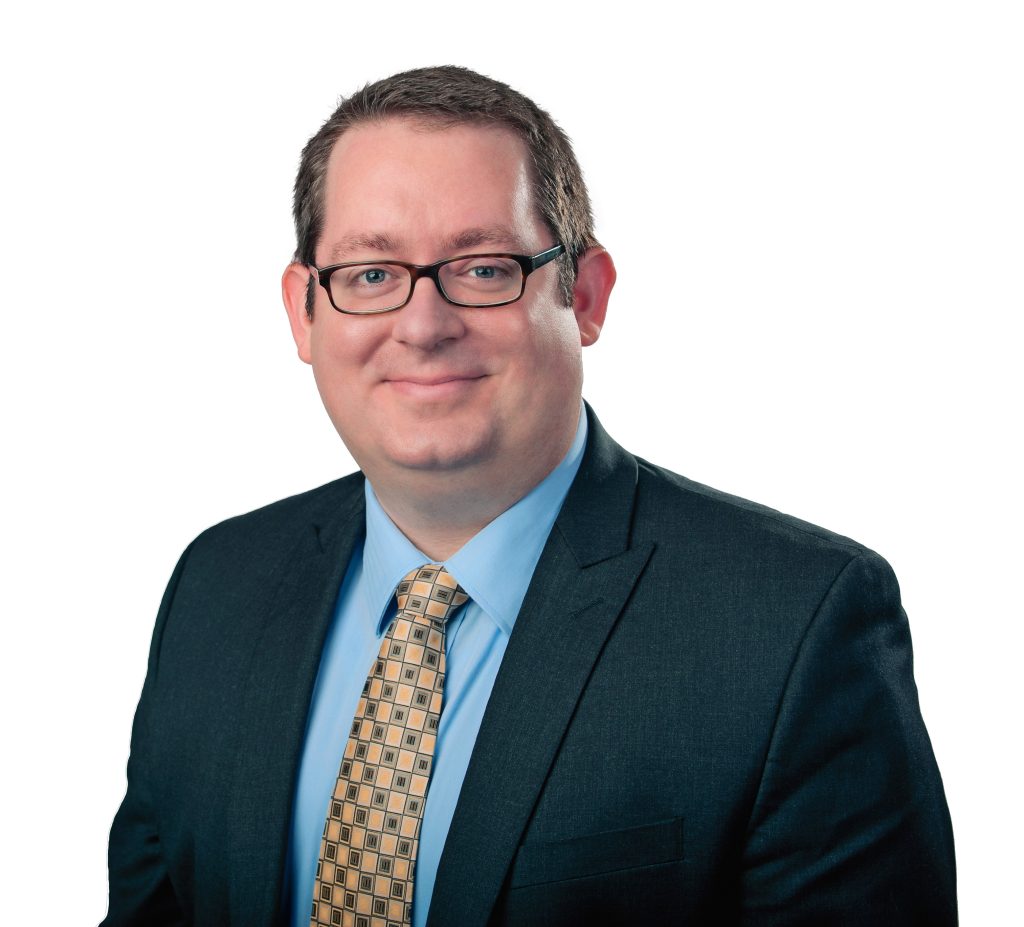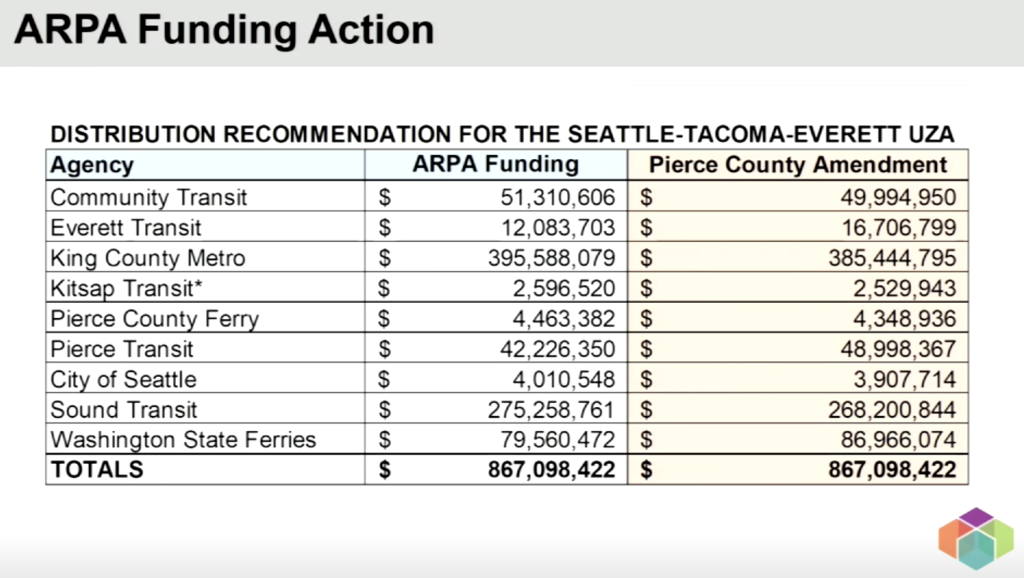Pierce County representatives argued that transit riders in their districts are being left behind by the Puget Sound Regional Council and the state.
In what was supposed to be a meeting about allocations of federal funding for transit, turned into a fiery, tense meeting about the future of the Puget Sound Regional Council (PSRC) on Thursday. The council’s Executive Board debated regional equity, funding allocation amounts, and even if Pierce County has a place in the body anymore. At stake was just over $900 million in federal pass-through money to keep eight of the region’s transit agencies running and shore up finances blunted by the pandemic.
Road to more federal funding
Since 2020, Congress has passed three rounds of pandemic response relief funding with latest passed and signed into law in March delivering over $30 billion to transit nationally through the American Rescue Plan Act (ARPA) of 2021. This was an early win by President Joseph R. Biden who backed the economic relief package. Prior allocations under the Coronavirus Response and Relief Supplemental Appropriations Act of 2021 (CRRSAA) and Coronavirus Aid, Relief, and Economic Security (CARES) Act were made in April of this year and April of 2020; those two allocations alone have delivered more than $1.14 billion to transit agencies in the region.
Federal pass-through transit funding is based upon statutory formulas for urbanized areas (UZAs). For Puget Sound, that means there are several UZAs that qualify for statutory formula grants, including Mount Vernon, Olympia-Lacey, Bremerton, Marysville, and Seattle-Tacoma-Everett. The latter three fall under the PSRC for allocations while the former two are allocated by their own metropolitan planning organizations.
As part of a long-standing practice, the PSRC makes allocations to transit agencies based upon an “earned share methodology.” This distribution methodology considers a transit agency’s operating and service characteristics in determining allocations. In simplistic terms, the more service an agency provides to riders, the more federal pass-through funding it will get to support those investments.
What’s equity in funding?
This practice received criticism in 2020 by boardmembers like Pierce County Councilmember Derek Young who said that allocations should include greater equity. To address some of this criticism, the Executive Board approved this April’s allocations with a 2.5% equity adjustment. That allowed Pierce Transit, Everett Transit, and Washington State Ferries to receive more funding than they otherwise would have been entitled to under the typical earned shared methodology.
For the latest round of funding allocations under ARPA, the equity discussions were raised again. A special caucus met to reach consensus on how Seattle-Tacoma-Everett UZA allocations should be made with various considerations in mind and equity. But those discussion folded without agreement on changes. So a recommendation on allocations fell to transit agency leaders within the region.
At the end of August, regional transit agency leaders recommended that the PSRC move forward with the typical earned share methodology but with a 2.5% equity adjustment for Pierce Transit, Everett Transit, and Washington State Ferries again. This recommendation was provided to the Executive Board on Thursday, but it immediately came with questions and concerns by boardmembers.
Hester Serebrin, a member of the Washington State Transportation Commission and Policy Director at Transportation Choices Coalition, asked agency staff if there was any definition of “equity” for allocations.
“There isn’t any specific definition of equity. We had three transit agencies in the region — Everett Transit, Pierce Transit, and Washington State Ferries — voice concerns that the earned shared methodology did not meet their needs,” said Josh Brown, Executive Director of the PSRC. “So there’s not a statistical analysis, definition, formula. Simply through that conversation and collaboration amongst the transit executive’s there as a decision that all the transit agencies, except for those three, would take a 2.5% reduction and those funds were then redistributed to the three agencies requesting additional monies.”
Everett Mayor Cassie Franklin followed on to say that the “earned share model is not equitable to transit agencies that do not have the funds to grow to meet the need in communities that we’re serving.” She added, “So if we’re basing the allocations strictly on the rate of how much service we’re providing, how are we ever going to get ahead in providing more service if that is the only tool used?”
A pitch for larger equity adjustments
Councilmember Young then proposed his amendment to the allocations, which would have increased the equity adjustment to 5% for Pierce Transit, Everett Transit, and Washington State Ferries. He said that some PSRC members aren’t getting “equity” and that despite discussion around it, the body hasn’t “been throwing actions behind those words.” He was clear that the base 2.5% equity adjustment proposal wasn’t fair and that even his 5% version wasn’t enough.
Before getting to a vote, Young discussed why there is a severe imbalance in transit funding and service across the urban region. “The problem has its roots not in our organization, but in the legislature. It’s the way we fund things in Washington, particularly around transit, and that is almost entirely localized at this point and based on sales tax,” he said. “So, what that means is that agencies that don’t have, that weren’t able to pass through voters the full amount [of authorized transit sales tax], which Pierce Transit has narrowly failed twice and will probably seek it again, means we can only raise two-thirds of revenue that other agencies can. Then on top of that, for every dollar that is raised through sales tax in King County, Pierce County can only raise 60% and that’s due to wealth.”
Pierce County’s under-invested in
Young isn’t wrong. Pierce County has long been a bastion for anti-tax sentiment and part of that has meant a serious lack of investment in public services and assets (excluding, of course, the immense highway expansions that continually have been made by the state), leaving a legacy of partially self-inflicted disinvestment over many decades. The county has also drawn its urban growth boundary so widely that it has meant very low densities, high costs of public services, and lower tax bases.
Pierce Transit is one example of under-investment and an over-stretched public service. The agency primarily gets revenues through the local sales tax, which is limited to 0.6% right now instead of the full 0.9% authorized by state law for transit. Thus, service growth has been fairly limited over the past decade. In fact, the agency actually went through a process in the 2010s to de-annex expensive-to-serve areas that contributed to the failure to raise the local sales tax and save bus service after the Great Recession era that saw drastic cuts throughout the region. Based upon the earned share methodology, Pierce Transit is generally entitled to a smaller proportion of federal funding than agency counterparts who have more service and funding proportionally. Of course, that doesn’t necessarily bear out on riders actually served.
A failed vote, but agreement on state action
Poulsbo Mayor Becky Erickson asked a question that many were probably wondering, “How does Washington State Ferries need any equity?” That agency gets money from the gas tax in addition to user fees; it also serves a much more well-to-do set of riders than most transit agencies and serves motorists. The state legislature could simply augment the amount of gas tax to offset shortfalls, something state legislators have been loath to do for actual transit agencies* with state resources.
Another point Mayor Erickson brought up is that Kitsap County voters have been willing to tax themselves for transit even in an area that is fairly hard to serve given how rural much of the county is. She said that areas willing to shoulder financial burden should also reap the benefits for doing so.
Nevertheless, there was consensus among many members of the board, including King County Executive Dow Constantine, Pierce County Executive Bruce Dammeier, King County Councilmember Claudia Balducci, and Commissioner Serebrin that local officials should lobby the state legislature to do its job and fund transit.
When the vote on Councilmember Young’s amendment came down, it was easily defeated with 64% against. But that then precipitated Young to urge a “no” vote on the allocations altogether to stall the disbursement of funds and force further discussions on his equity concerns. He said, “This is wrong, it’s just absolutely wrong and we’re going to discuss here shortly why it’s wrong and I think all of you know it.”
Councilmember Young pointed out that Pierce Transit serves more people in “target demographics” than most other transit agencies. “More than half of our riders are in poverty,” he said, which is much higher than most in the region. “And as we were talking here, I got another cancellation notice for my particular route,” he added. “This is a daily occurrence now and what that means to us, my route in particular is on hour headways. That is just barely making it, and frankly for most people it’s woefully inadequate.” It would be hard for any to argue that hourly or worse headways as being anywhere near reasonable in urban areas, with or without cancelled trips, and Councilmember Balducci said as much in her own comments.
The future of Pierce County called into question
Before a final vote, Councilmember Young issued a strong warning to the PSRC. “This is unacceptable. We have to make a change and it’s not just a change in how we distribute [funding]; it’s a change in philosophy for this organization,” he said. “And I think we’re at a point where Pierce County is starting to realize that’s not going to change. I question our future in this agency.” He further added that the ensuing vote to approve funding with only a 2.5% equity adjustment would be an “offensive act.”
While boardmembers seemed to understand Young’s concerns and frustration, his comments were not well received with members piping up to express that.
Rounding out the discussion, Councilmember Balducci jumped in to talk about how the PSRC might tackle equity going forward. “I think that there’s some good analysis and transparency that can be brought to this discussion about the relative size and scope of the different agencies, about service populations, about gaps in service…especially around racial and economic attributes of places that are well served and not as well served,” she said. “I would love to see a full analysis with context that shows regionally how we are really doing and then uses that analysis to have a real discussion about our policies going forward.” Balducci further emphasized that members of the PSRC have a lot of common interests and issues.
The final vote passed with 85% of membership in support; Pierce County and Other Cities and Towns in Pierce County were the only members to oppose the measure.
The final allocations
Ultimately, approved funding distributions by transit agency break down as follows:
- $395,588,079 for King County Metro;
- $275,258,761 for Sound Transit;
- $79,560,472 for Washington State Ferries;
- $57,431,344 for Community Transit;
- $42,226,350 for Pierce Transit;
- $30,851,189 for Kitsap Transit;
- $12,083,703 for Everett Transit;
- $4,463,382 for Pierce County Ferry; and
- $4,010,548 for City of Seattle.
Additionally, federal funding has been allocated to several other Puget Sound transit providers, including:
- $26,055,858 for Intercity Transit;
- $21,226,320 for Whatcom Transit Authority;
- $7,347,458 for Skagit Transit;
- $155,335 for the Stillaguamish Tribe of Indians;
- $122,964 for the Mukelshoot Indian Tribe;
- $57,095 for the Snoqualmie Indian Tribe; and
- $19,337 for The Tulalip Tribes.
*The Urbanist does not consider the state ferries system as categorically transit because they’re designated and funded as state highways and are disproportionately designed to serve cars.
Stephen is a professional urban planner in Puget Sound with a passion for sustainable, livable, and diverse cities. He is especially interested in how policies, regulations, and programs can promote positive outcomes for communities. With stints in great cities like Bellingham and Cork, Stephen currently lives in Seattle. He primarily covers land use and transportation issues and has been with The Urbanist since 2014.





